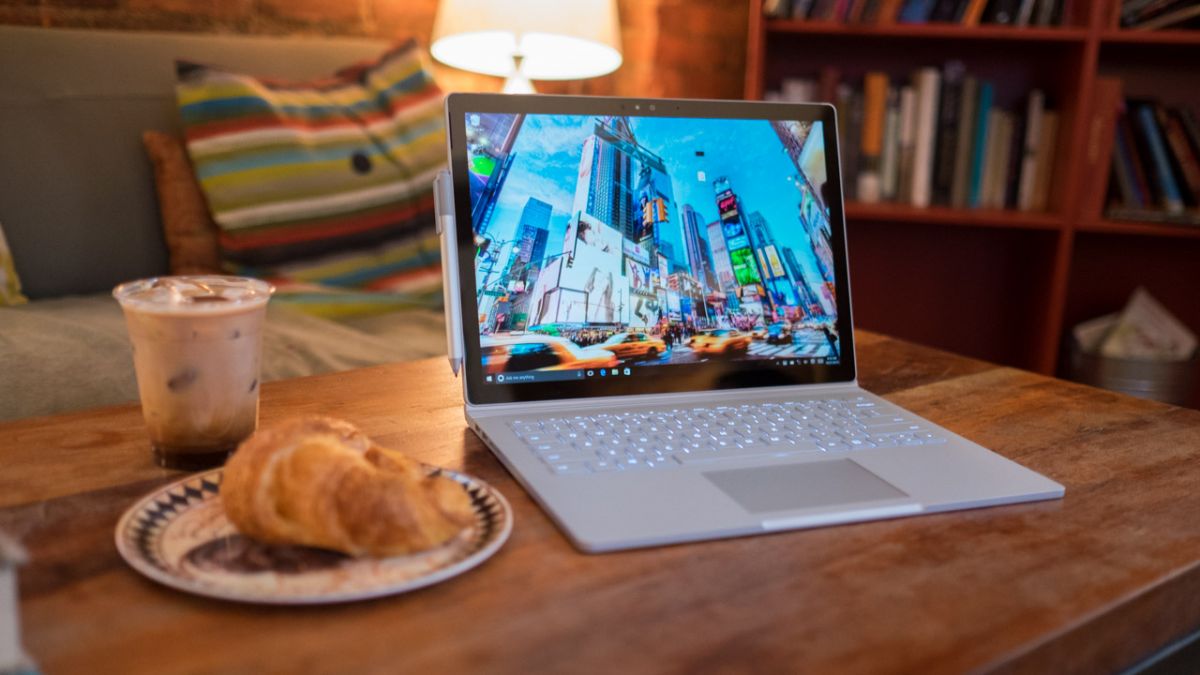
Introduction and design
Update: Microsoft’s Surface Book is now available with more storage and memory.
In its short tenure as a hardware maker, Microsoft has become the defacto trailblazer for Windows-running devices. It all started with the lofty promise that its Surface tablet could replace your laptop. We were skeptical about it three years ago, but after the Surface Pro 3, Microsoft nearly perfected the formula and showed veteran computer manufacturers how hybrids should be made.
Now, Microsoft introduces the Surface Book as the “ultimate laptop.” Like the Surface tablets before it, this laptop takes a unique spin on the notebook format that’s been around for over 40 years. Between the 3:2 aspect ratio, 13.5-inch screen and its practically-trademarked “dynamic fulcrum” hinge, there isn’t any machine on the planet like the Surface Book – and then, with the touch of a button and a gentle tug, it becomes a tablet.
It all sounds like an amazing idea on paper, and with the added “holy shit, Microsoft made a laptop” factor, the Surface Book sounds like a thoroughly amazing device. Let’s see just how well Redmond made good on the hype.
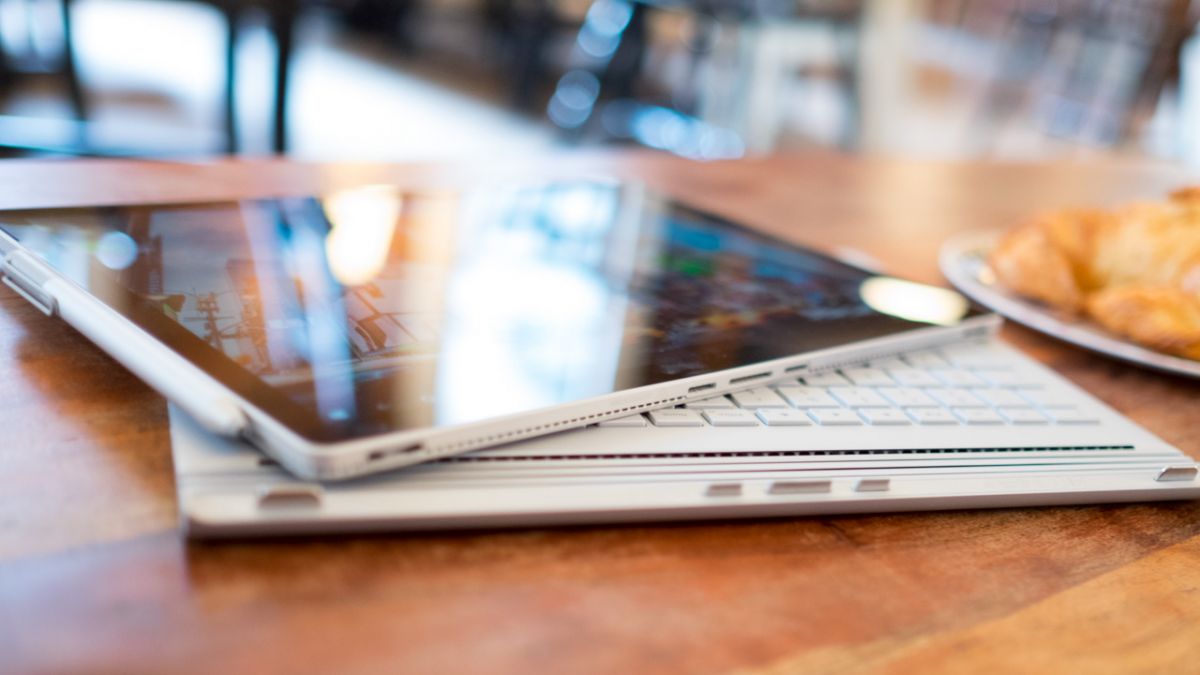
Design
If a tear in the space-time continuum were to suddenly rip open, two things would fall out: the Terminator and then the Surface Book quickly tumbling to the Earth behind it. From the snake-like hinge, the flat design and even down to the washed-out silver color of this laptop, everything about it just seems like it came from the future.
Milled from two solid blocks of magnesium, the Surface Book feels sturdy and has a most minimalistic style unto its own.
From keyboard deck to the palm rests, the entire interior of this laptop is one flat surface of metal, save for the large space reserved for the glass touchpad. Similarly, the screen lid is made of one uninterrupted slate of magnesium, with its only extra flourishes being a mirror-finished Windows logo in the center and a rear-facing camera.
Along the chiseled sides, you’ll find two flat edges that start from the top of the display and terminate at the tip of the palm rest. That’s not the only seamless transition.
Unlike most other convertible devices, the screen and base sections share nearly the same thickness and weight. Without the foreknowledge that the display can actually detach, the Surface Book looks like one continuous device, thanks to the hinge.
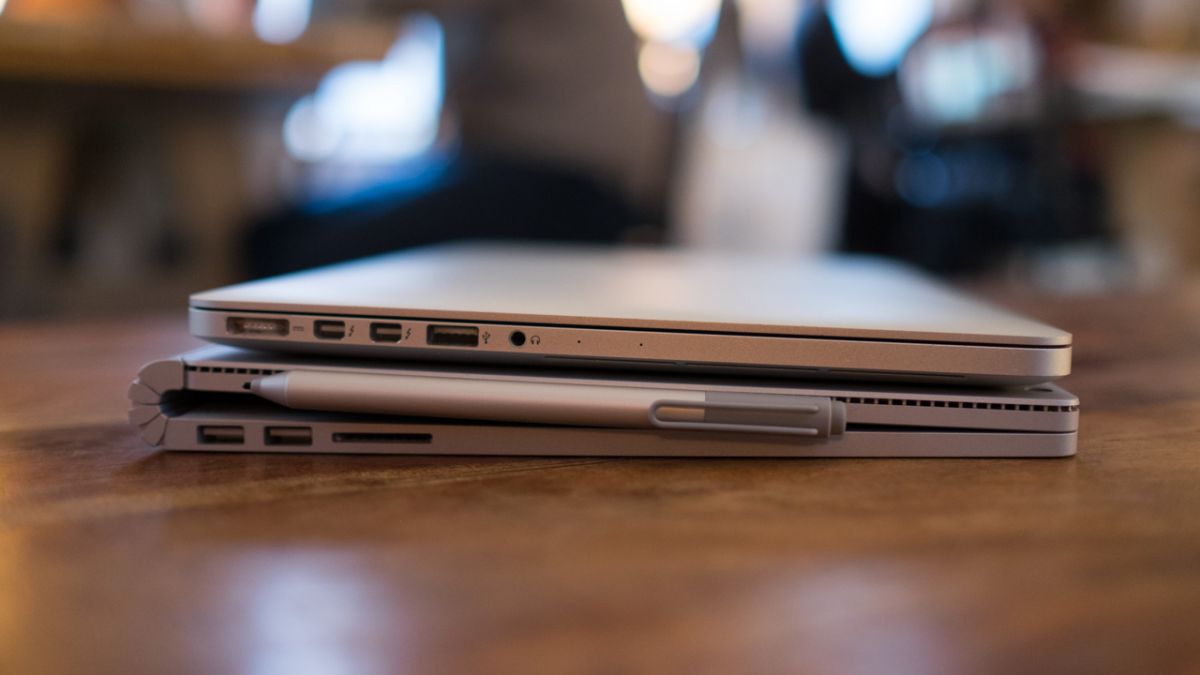
Mind the gap
At the midpoint of the Surface Book, there’s a piece of connective tissue that Microsoft calls the dynamic fulcrum hinge. On top of simply gluing the screen and keyboard base together, it’s this key piece that makes the whole device work.
Rather than folding flatly, the hinge basically coils into itself, leaving a noticeable gap between the screen and keyboard when the unit is closed. When opened, this same part rolls out and actually extends the base of the laptop, which in turn helps extend the support base for the tablet portion of the Surface Book (called the Clipboard).
While a traditional notebook display might weigh half a pound at most, the top section of the Surface Book weighs 1.6-pounds, because it contains all the necessary parts to act as a standalone tablet. As such, the hinge has been reinforced and contains extra mechanisms, not unlike the Lenovo Yoga 900’s watchband-style hinge to keep it in place.
Surface Book is solid as a rock, and you can even pick up it by the display and shake it about without worrying about the whole thing falling apart. On a flat surface, the screen is held steady in place and even stays put when you have it in your lap.
The only times the screen wobbles are when I’m poking at it with my finger or the Surface pen, but that really comes with trying to operate a touchscreen on any laptop.
And to address the concerns of the gap left in the middle of the system. Yes, there is a substantial open space in the middle of the system when it’s closed. No, dust and other bits of nasty will not slip into the interior anymore than with a standard laptop, unless you’re a particularly messy person. After a week of using the Surface Book religiously, I can run my finger against the inside edge of the hinge and not find a single speck of dust.
Another plus side of having a laptop that doesn’t close completely flush is you’ll never find any oily outlines of the keyboard imprinted on the screen. It’s a design element that also eliminates the need to seat the keyboard into a recessed area. Instead, the keys on this laptop sit flush with the keyboard deck.
The keyboard itself offers a splendid 1.6mm of key travel that caps off with a satisfying thwack when you bottom out the keys. The trackpad is equally as enjoyable, with it’s glass laminated finish. For the first time ever, I found myself interested in using the three-finger multi-gestures to rotate through windows and reveal the desktop.
While this is a tiny element of the Surface Book, few – if any – other Windows notebooks on the market today offer such a tight tracking experience.
Mobilizing the desktop
The Surface Book’s other signature trick is the screen can pop off the base with just the tap of a button. Technically, Microsoft is coming late to the 2-in-1 laptop game with various devices being able to do the same, including Acer’s Switch family, Toshiba’s Click notebooks, some HP devices and the list goes on.
However, no one has made a system as seamless as the Surface Book.
Undocking and attaching the Clipboard is nearly as seamless as the Surface Book’s design. After either pressing the eject button on the keyboard or the virtual button in the taskbar, the screen will blink off for a second and then notify you it’s safe to detach the screen with one quick tug.
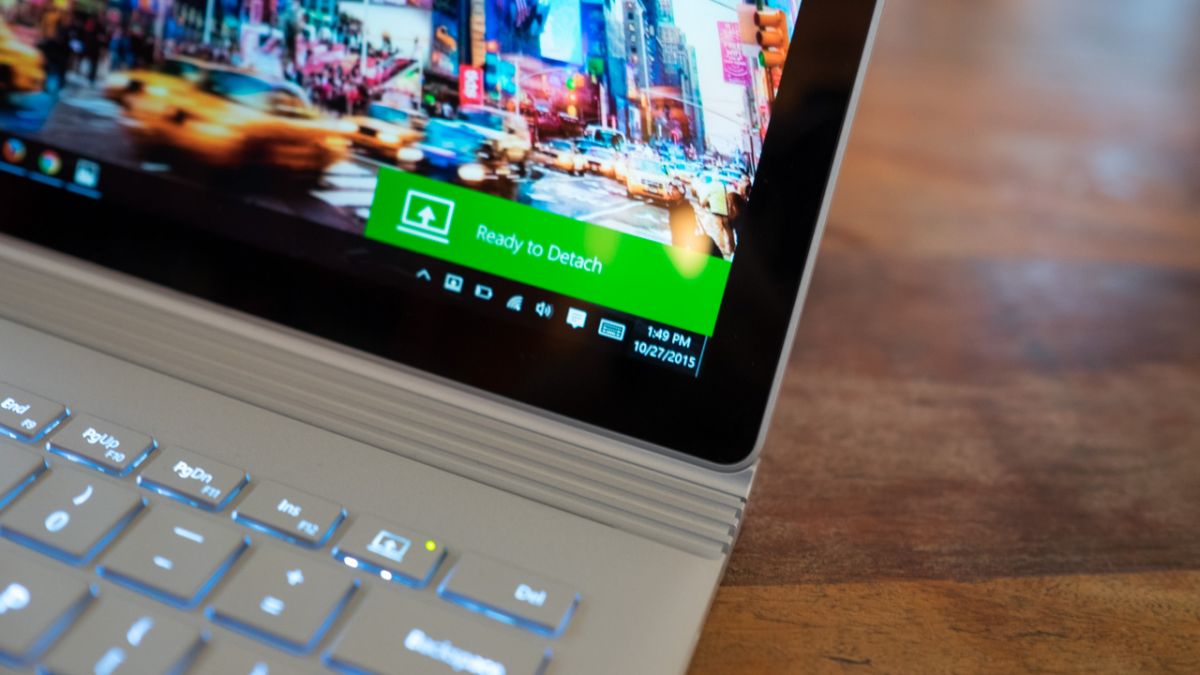
It’s fast and simple, however, the timing takes a little getting used to. After you get the prompt to detach the screen, you have to wait for about half a second before you can actually lift the display off its base.
Another unique feature to this notebook is it’s the first to integrate a discrete graphics processor, or GPU, into a hybrid system. Tucked underneath the keyboard is a customized Nvidia GeForce GPU that makes this laptop just a bit more capable with media production and gaming.
We’ve seen this sort of GPU docking technology before in machines like the MSI GS30 Shadow with GamingDock and Alienware’s GPU Amplifier solution. Microsoft has improved upon dockable graphics, as the Surface Book just needs a short moment to disengage the extra parts, whereas both the Alienware and MSI solutions require the laptop to reboot completely.
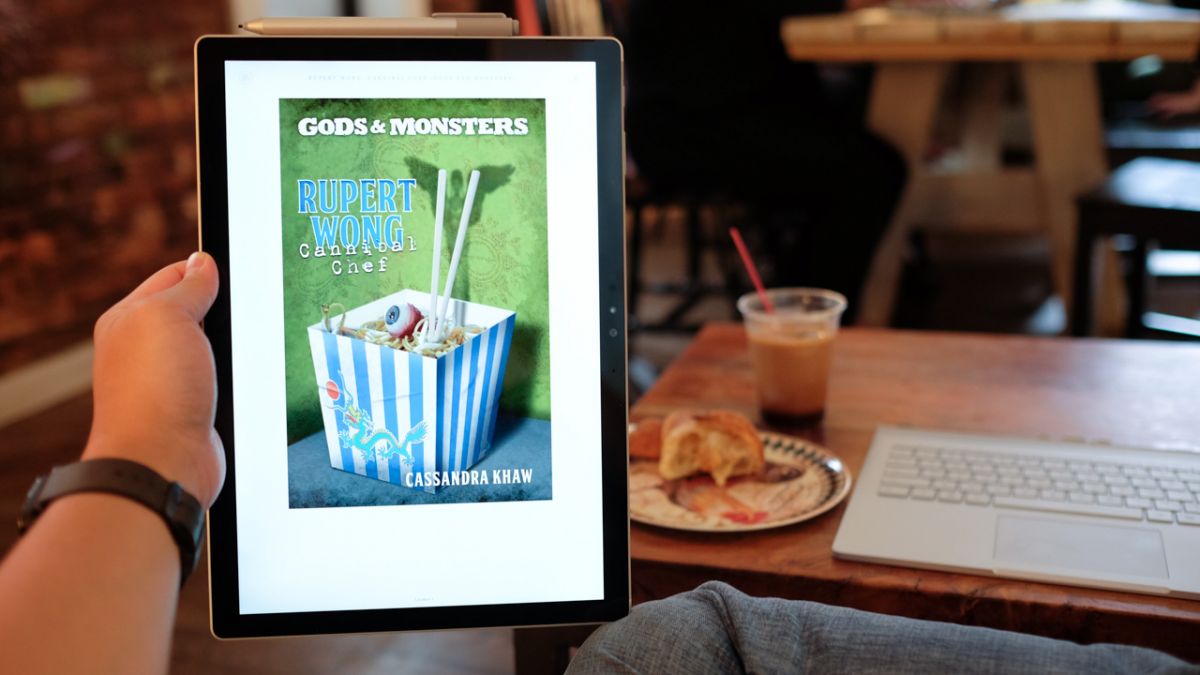
It’s a neat feature that allows me to quickly show a friend something cool or when I want to read a digital comic book without having to lug the whole laptop around. But it didn’t really click with me until I realized how easily it lets me bring my entire PC to another place without having to disconnect my external monitor, keyboard, mouse, Xbox controller and all my other peripherals at home
It’s the coolest mechanic since the saucer separation of the Enterprise-D. What’s more, it leaves open a door to expandability. Because the Clipboard is compatible with all Surface Book keyboard bases, not just the one it shipped with, Microsoft could theoretically come out with future upgrades could be done through new bases. (Or maybe even a desktop rig that interfaces with the display? We can dream.)
Specifications and value
With a starting weight of 3.34 pounds (1.51kg), the Surface Book is one of the heaviest 13-inch laptops. And that’s without the optional, discrete GPU, which ends up adding a few extra ounces and bumps up this laptop’s total weight to 3.48 pounds (1.58kg). While this might look like a lot on paper for an Ultrabook-class device, consider the 13-inch MacBook Pro weighs just as much despite it packing a smaller screen, no dedicated GPU and fewer batteries. For a closer look at how the two devices compare, check out our Microsoft Surface Book vs Apple MacBook Pro versus article.
If you’re looking for the power of a discrete GPU in an Apple device, you’ll have to go all the way up to a high-end 15-inch MacBook Pro. And this is a machine that is significantly heavier (4.49 pounds or 2.04kg) and larger (14.13 x 9.73 x 0.71 inches or 359 x 247 x 18mm).
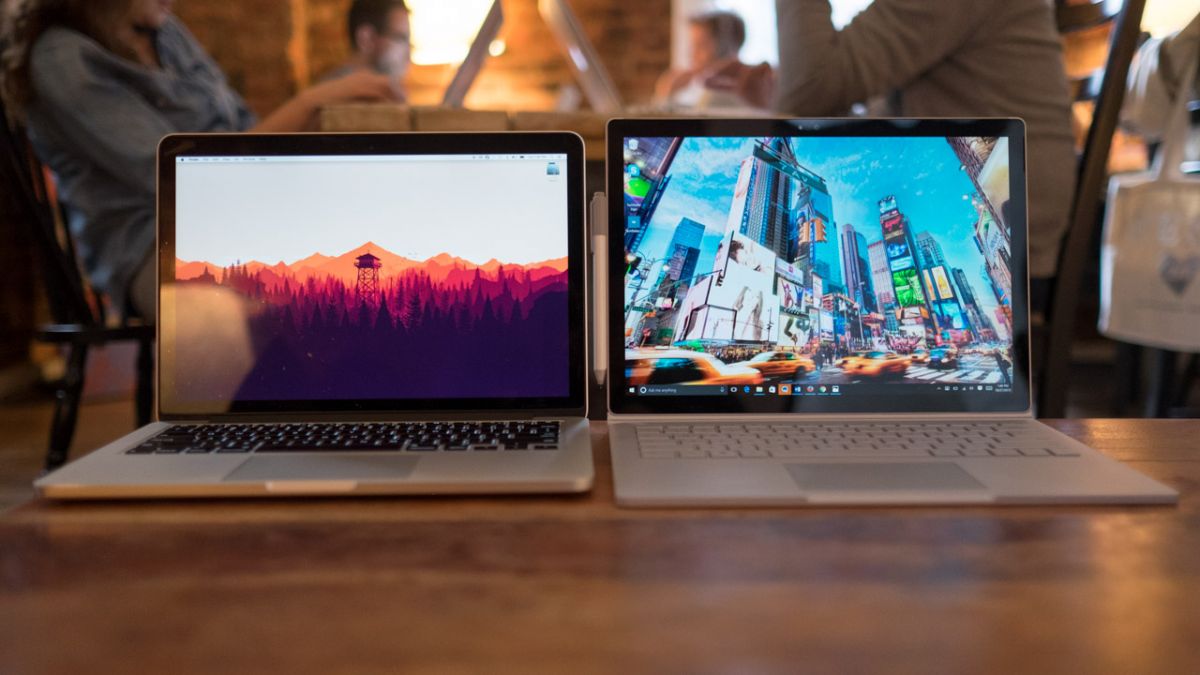
Thanks to its 3:2 aspect ratio and having a 13.5-inch screen, the Surface book is quite a bit taller than your average 13-inch laptop. Despite its peculiar 12.3 x 9.14 x 0.51-0.90 inches or 312 232 x 13-22.8 mm (W x D x H) dimensions, I had no problem slipping this laptop into bags designed to hold a traditional 13.3-inch laptop.
The Dell XPS 13 comes as the antithesis to the Surface Book in its mission to be the smallest 13-inch laptop in the world, weighing in at 2.8 pounds (1.27kg) while measuring 11.98 x 7.88 x 0.6 inches (304mm x 200 x 15mm).

Spec sheet
Here is the configuration for the Microsoft Surface Book techradar reviewed:
- Processor: 2.4GHz Intel Core i5-6300U (dual-core, 3MB cache, up to 3GHz with Turbo Boost)
- Graphics: Intel HD graphics 520; Nvidia GeForce graphics (1GB GDDR5 high-speed memory)
- RAM: 8GB
- Screen: 13.5-inch, 3,000 x 2,000 (267 ppi) PixelSense Display
- Storage: 256GB PCIe3.0 SSD
- Ports: 2 x USB 3.0, mini DisplayPort, SD card reader, mini headphone/mic combo jack
- Connectivity: 802.11ac 2×2 MIMO Wi-Fi, Bluetooth 4.0 LE
- Camera: Windows 8MP rear-facing auto-focus camera (1080p HD), 5MP front-facing Hello face-authentication camera (1080p HD)
- Weight: 3.48 pounds (1.58kg)
- Size: 12.3 x 9.14 x 0.51-0.90 (W x D x H) (312 x 232 x 13-22.8 mm)

With an $1,899 or AU$2,949 (about £1,239) price tag for the configuration above, the Surface Book asks for a pretty penny that’s typically reserved for high-end gaming notebooks. And that’s even applicable to the $1,499 or AU$2,299 (about £978) price associated with its most basic configuration, which is essentially a more expensive Surface Pro 4.
Not just a joke either, Microsoft’s two Surface devices shares very similar standard specs including the same processor, storage space and memory allotment. However, there are several key differences, as Microsoft’s first laptop possess a larger screen and a completely different design. It’s for this reason, it makes sense to either throw in an extra couple of dollars in the hole to get the $1,699, US-only unit with discrete graphics and 128GB of storage space.
If you want to go whole hog on Microsoft’s hybrid, you could also pick up a 1TB configuration that comes with an Intel Core i7 CPU, a discrete GPU and 16GB of RAM for $3,199 – but again, unfortunately, this is a US-only configuration.
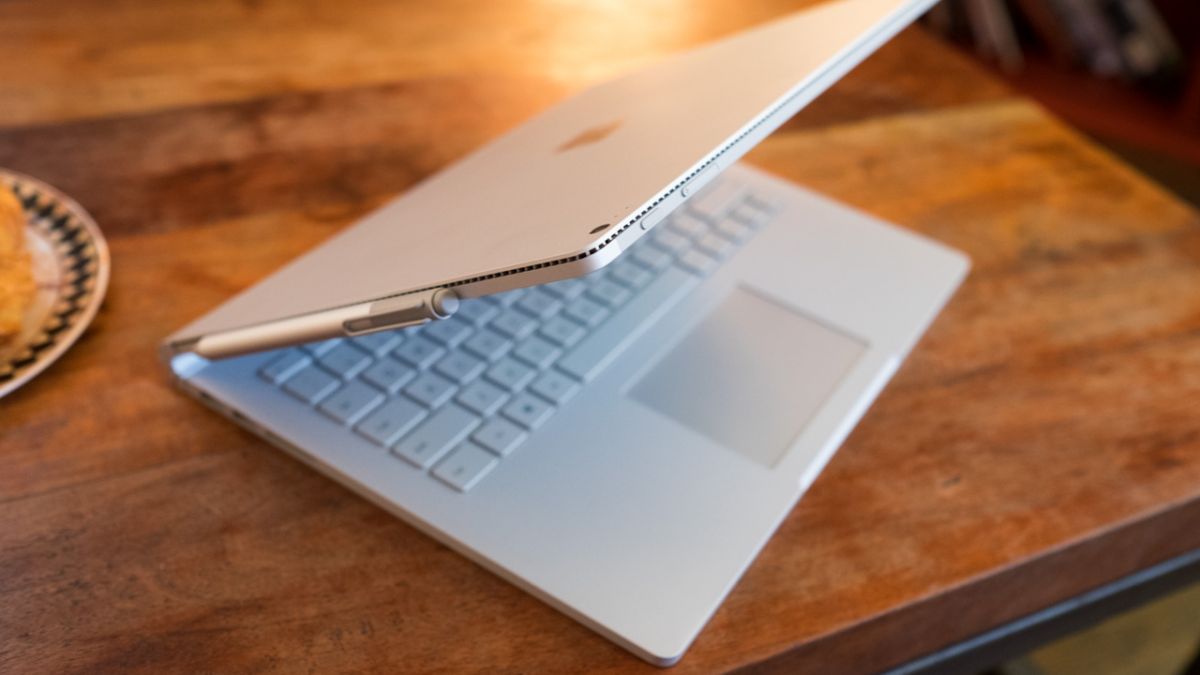
The well-equipped, Skylake-powered Dell XPS 13 can be had for $1,649 (£1,149, $2,499). While it does not come with a discrete graphics chip, the XPS 13 has a leg up on the Surface book with a 3,200 x 1,800 resolution display and a 2.5Ghz Intel Core i7-6500U processor.
The 15-inch MacBook Pro is by far the most expensive machine, ringing up for $2,499 (£1,999, AU$3,799). However, for this kingly sum, it comes with double the RAM and SSD storage space, an AMD Radeon R9 M370X GPU, and it’s the only one with a quad-core processor. Unfortunately, it has the lowest resolution display, pushing only 2,880 by 1,800 pixels.
If you’re looking for something to serve your basic mobile computing needs, then the Dell XPS 13 is your smartest and most economical choice. However, if you’re looking for something flashier and can do more, then the Surface Book is your ticket. For those who need a production workhorse, the 15-inch MacBook Pro still wins this race against Microsoft.
Performance and features
With a dedicated GPU, naturally the first tests I conducted were gaming ones. The Clipboard and its Skylake processor have more than enough power to make Hearthstone fly, even at full resolution. Plugging the display into the keyboard base unlocks even more performance from the dedicated GPU. With the discrete graphics chip in tow, the Surface Book can play Rocket League at 30 frames per second (fps) in full screen and medium settings.
For more serious games, like Metal Gear the Phantom Pain, I was able to get it running between 24 to 29 fps, but only after dropping the resolution to 1,920 x 1,080 and practically turning off all the settings. Microsoft’s first laptop won’t be replacing your PC gaming rig any time soon, but it’s surprising how well this machine gets along with only 1GB of video RAM.
Of course, all this power also makes the Surface Book a productivity beast that easily takes on task after task. Lightroom runs incredibly fast on this 13-inch laptop, thanks to the added power of the Nvidia graphics. What’s more amazing is I’m able to edit photos quickly while I have a browser full of 10 tabs and streaming video pushed over to a connected monitor.
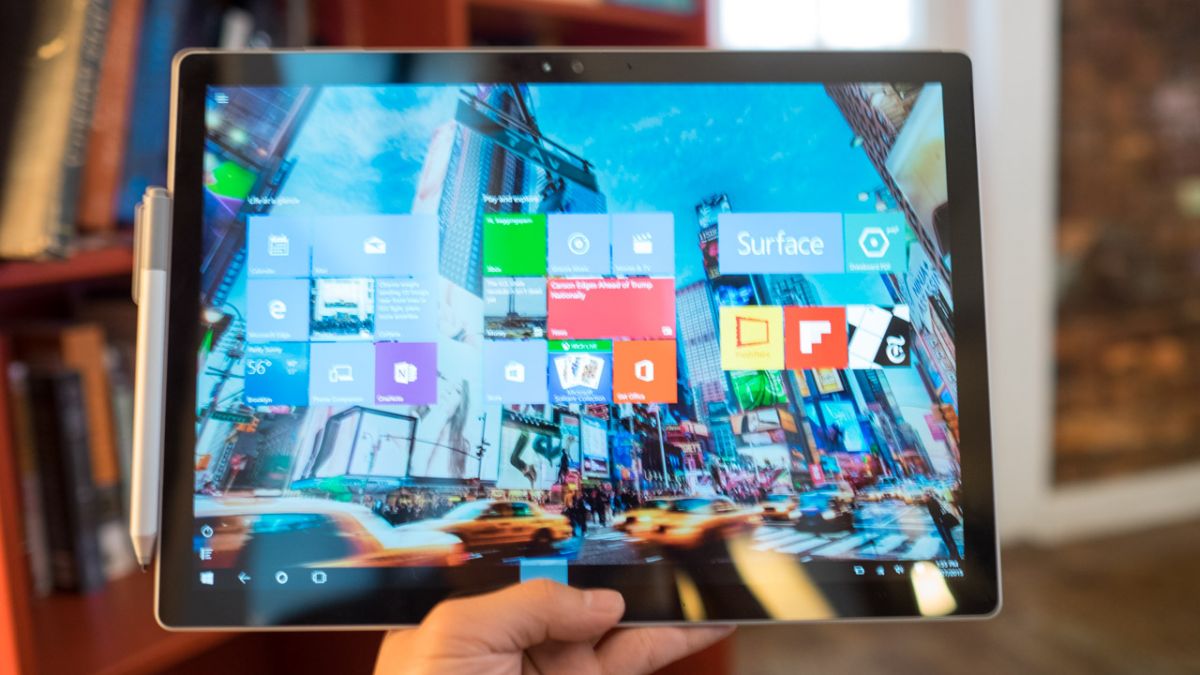
Benchmarks
Here’s how the Microsoft Surface Book performed in our suite of benchmark tests:
- 3DMark Cloud Gate: 7,285; Sky Diver: 6,089; Fire Strike: 1,868
- Cinebench CPU: 301 points; Graphics: 32 fps,
- GeekBench: 3,166 (single-core); 6,635 (multi-core)
- PCMark 8 (Home Test): 2,336 points
- PCMark 8 Battery Life: 3 hours and 58 minutes
The Surface Book has broken all sorts of benchmark speed record, thanks to its hot new Intel Skylake and Nvidia GeForce chipset. Just in terms of processing power alone, it’s 301-point Cinebench score is significant jump compared to the Dell XPS 13, which ran with a last-generation Broadwell Intel Core I5 chip.
Thanks to the extra boost from the discrete graphics chip, the Surface Book also has more than double the performance for gaming. This is evidenced by its 1,868 point Fire Strike score compared to the Dell’s 739-point performance.
The only figure I can draw to compare this machine to the 15-inch MacBook Pro is the GeekBench score. In the multi-core test, Microsoft’s laptop finished with 6,635 points, whereas two outlets saw the 15-inch Apple’s steely steed completed the test with an average of 14,258 – an unsurprising result, considering the MacBook Pro has twice the number of processor cores.
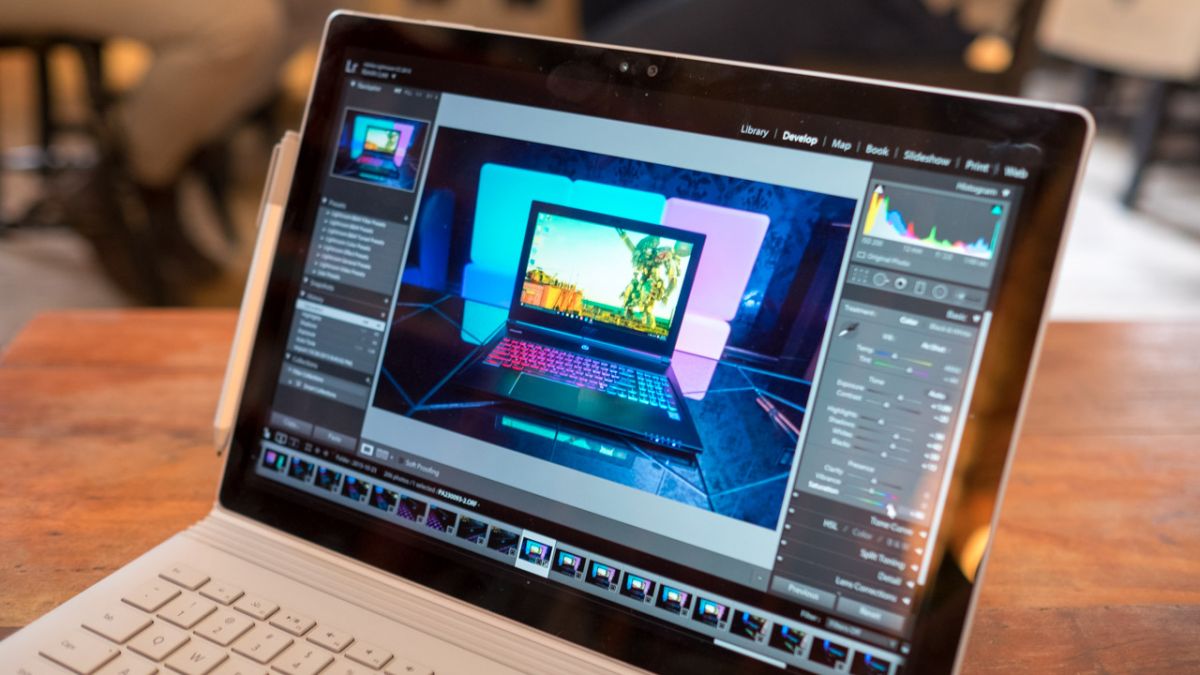
Pixels to please
With 3,000 x 2,000 pixels under its belt, the Surface Book sits at a happy middle ground of being sharper than most other laptops (including every MacBook in existence) without the troubles that plague 4K screens. You’ll never see the separation between the pixes, l because they’re so tiny, and Windows 10 scales beautifully at 200%.
While most applications, including the Origin, Steam and Battle.net launcher would look tiny on a 4K screen, these windows look small, but not uncomfortably so, on the Surface Book.
I even like the 3:2 aspect ratio. The ability to read more lines of text and not have a Lightroom window that’s not vertically squished together more than makes up for the thick black bars that appear when you watch movies. Microsoft fashions its displays after A4 paper, which makes the Clipboard feel like a natural device for writing and art work.
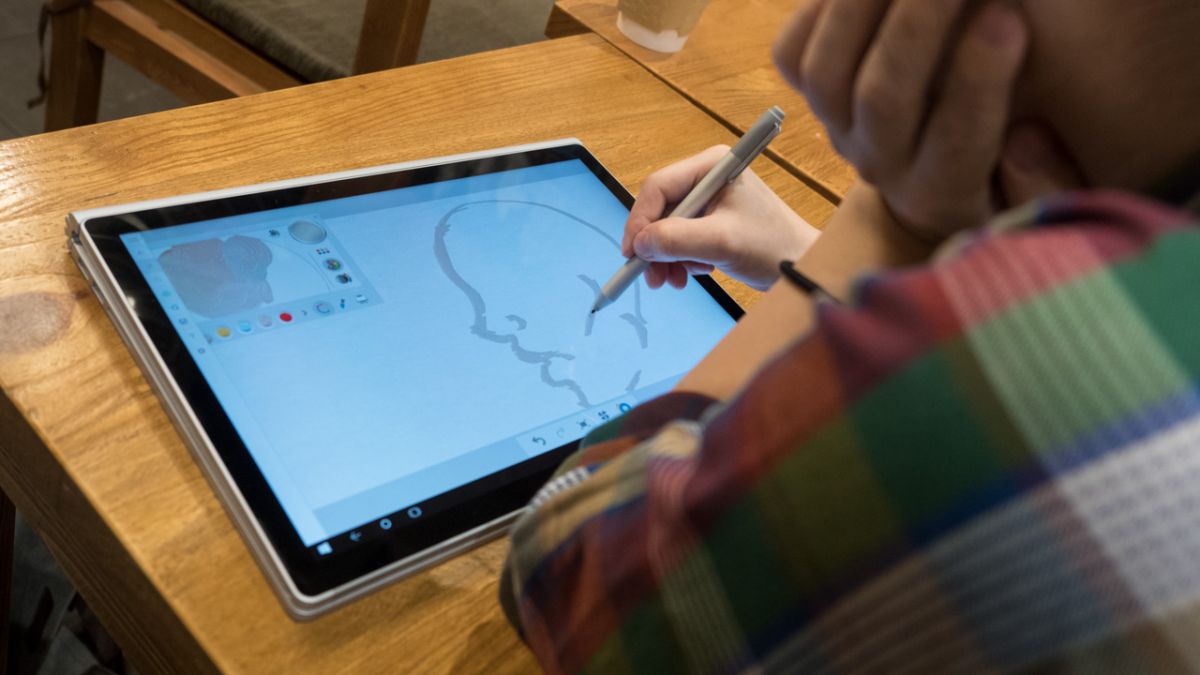
Within five minutes of handing the Surface Book over to an artistic friend, who works as a designer in the fashion industry, she was already drinking the Kool-Aid. According to her, using the Surface Pen is incredibly accurate, and the screen gives just enough to the point where it emulates the feel of painting and drawing on real paper.
Sadly, the speakers don’t make as big of an impression and really only sound good enough for some casual listening. While they avoid the problem of being tinny, as most laptop speakers are, they also lack any depth with barely any bass. If you’re looking to settle down for a movie or a quick game, you’ll want to plug in a pair of headphones.
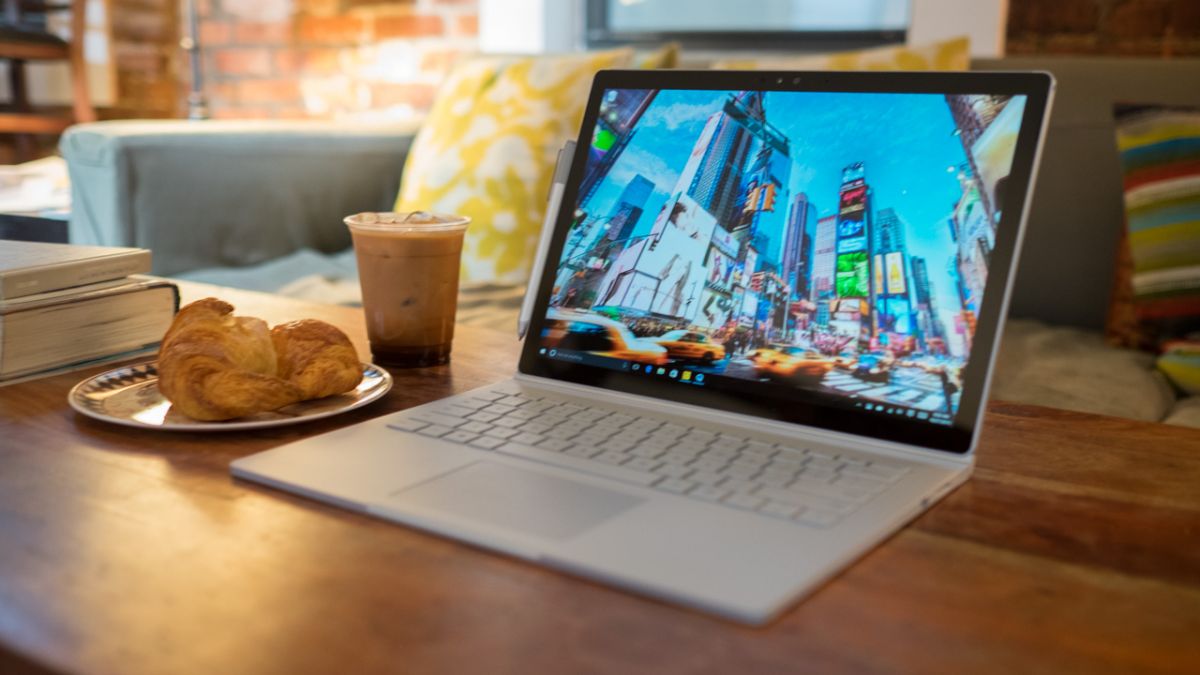
Battery life
Battery life on the Surface Book is both pretty good and surprisingly disappointing. While Microsoft has promised 12 hours of continual usage and other outlets report getting even more juice out of the machine, our best time for the device was 7 hours and 39 minutes. As for the Clipboard on its own, the tablet can last for 4 hours.
While these are more than respectable numbers considering all the hardware inside the Surface Book, I honestly expected a much longer run time. The good news is this notebook recharges quickly, going from zero to 100% charge in under two hours.
This could largely be due some problems early Surface Book owners are running into. My unit seems to be among this group of afflicted models. Just some of the major bugs include the system not starting up properly when connected to the dock and display driver failures. The latter of which cause battery life to drop dramatically by three or more hours.
Microsoft has said it is “aware of aware scenarios where Surface Book’s display may deliver a display driver error and that we’ll address through fixes issued via Windows Update within a few weeks after launch.”
By comparison, the older generation Dell XPS 13 lasted for 7 hours and 40 minutes, while several outlets were able to stretch their usage of the most recent 15-inch MacBook Pro for an average of 9 hours and change. So again, the Surface Book’s battery life is by no means terrible, but it could get a lot better with future updates.
Verdict
Now, the question is: has Microsoft made the ultimate laptop? And the answer is not quite – not quite yet, anyway. The Surface Book still has some growing pains to get through, and its substantial size may not jive with everyone. However, this is a great first crack, and it’s made the concept of 2-in-1 laptop look and sound more believable than anyone else has.
The majority of hybrid laptops to this point have followed the back-flipping model established by Lenovo’s Yoga series. This is largely because models with detaching screens were clunky and chunky, but Microsoft has turned the perfected the concept by splitting the laptop in half.
All the essentials for a Windows 10 tablet are packed into the Clipboard, which can be used as Surface tablet unto it’s own. But then the slate marries perfectly with its other half that contains extra batteries and a dedicated GPU.
We liked
The Surface Book’s design isn’t for everyone, but I simply fell in love with its futuristic look. Whether it looks odd or just ahead of the curve will depend on your perspective, but you can’t deny Microsoft has made a daring move with its dynamic fulcrum hinge. 2-in-1 laptops – and especially those of the detachable variety – have had their ugly duck moments. This is no such moment for Redmond.
Beyond looks, every design element of this laptop is full of purpose, from the rolling hinge to how quickly you can detach the Clipboard. The Surface Pen and the display work together beautifully for creating art that I will never understand beyond jotting down my notes in chicken scratch. And then there’s the Surface Book’s undying performance that just won’t let up whether you’re working on spreadsheets, editing photos or even enjoying some light gaming.
We disliked
While I praise this hybrid for its incredible performance, there are heavy limits on just how many games it will play with only one gigabyte of video memory. The early bugs are also something I can’t ignore, but they’re to be expected from the first run of the first laptop ever created by Microsoft.
Though some small parts of the Surface Book experience are borked as of this writing, you can bet Microsoft won’t be resting on its laurels. Updates will continue to come out quickly one after the other and just in the time of one week, I’ve already received two software patches that have fixed a few of my early problems with the device.
Final verdict
If you were to strip away the Clipboard’s ability to detach, the Surface Pen, the neatness factor of the dynamic fulcrum hinge and just about everything that makes the Surface Book unique, you would be still left with terrific laptop. That’s what I love the most about this device. Underneath all the extra stuff, the Surface Book is a solid laptop in terms of ergonomics, performance and, yes, even battery life despite the promises.
Incorporating all the extras – from the ability to run off with the clipboard, the incredible accuracy of the Surface Pen and the engineering feats of the hinge – they all serve to enhance the experience, rather than detract. In time, Microsoft will smooth out all the rough edges of its first go. Both the Dell XPS 13 and 15-inch MacBook Pro are well worth purchasing in their own right. But if you want an excellent laptop that does just a bit more, then the Surface Book is your ticket.
Source: techradar.com






































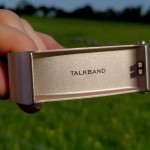



Awesome first gen product, but I'm worried about several issues that can arrise from long-term use of this machine :
1. Driver support : There is a lot of unqiue hardware on this, which means that drivers are not tested and ironed by time.
2. Long term support : Supposedly you buy the discrete version. I don't think that nvidia/ms will have enough long-term driver support for it, given that it is some sort of customised 940m, not a normal one.
3. Durability : The hinge and the detatch mechanism are something completely new and I don't think they will stand well in time as they have not been tested before.
4. Weak hardware, but that is not ms's fault. The screen res is too high and we all know that good 4k experience on a laptop will not happen with this gen's gpus. ( plus the cpus IS weaker than it sould).
5.Also, I wonder what will happen after someone formats this device ( since you have to do this in all windows computers if you plan on using them long-term).
yeah you should probably go get a mac so you you can use your computer reliably while still being a dumbass.
"electrical vibration" lol
>"just how many games it will play with only one gigabyte of video memory."
>"only one gigabyte of video memory"
>"only one gigabyte"
Busted the starbucks-drinking instagramming "tech" journalist. You have no idea about hardware lol
check out the 3min(?) mashable video review of the surface book on youtube.
the reviewer is shown to stand on the device/hinge with his full weight, with the device not affected in any way.
Wasn't a huge fan of the Surface Pro as I like a proper keyboard (read: couch and bed typing). Will definitely be purchasing this.
yeah please take that 10 pound box of steel everywhere you go along with your 4 inch thick laptop.
excellent laptop. i really recommend it.. been using it for a couple of days and it's the best:D
The MSI and Alienware enclosure solutions containing *desktop* GPUs are not comparable to this ffs!
Linus Tech Tips review says that when you press the detatch button it will notify you of which programms you need to save/close before you detatch it
No, I'm that guy who lives in a world where there are little particles of dust inside and outside my house, which can collect. You must live somewhere where everything is cleaned and sterilised every 5 minutes. My Macbook Pro keyboard gets little hairs on it, and some crumbs now and again, and thats when i'm typing, so the chance of that kind of stuff getting into it when its on a table is very high.
Unless you want to do nothing but sit at a table or desk with the Surface Book, do NOT buy it. The charger falls out simply by looking at it – the most ridiculous piece of technology I have ever used. Overpriced, overrated, the battery is terrible so you have to keep the charger in most of the time. I cannot believe what I have spent on a product I am unlikely to actually use.
Having the Surface Book i7 I can tell you that hinge is a beast! It is a lot stronger than it looks and when using it as a laptop there is no wobble suggesting that it does hold the tablet portion of the Surface securely. You can easily pick this whole unit up by the screen and it's not going to come apart by itself. Honestly it's some pretty cool tech and engineering the boys at Redmond were able to achieve.
if they want to make windows the perfect OS for this kind of laptops they need to make the entire thing more consistent and add apps that are targeted specifically for this kind of audience
Agreed. There are still some rough edges (inconsistencies) but you can see where it's heading and it looks great.
i've got the SP4 and by the sounds of it, I don't need an upgrade. If I do it'll be for vanity reasons only. But no mention on whether the screen can tilt in several different degrees as per the SP4? I like this feature and the Sbook doesn't look as though it has that prop/ ledge at the back?
Like the fact there is a gap between screen and keyboard when closed. The SP4 screen does leave a keyboard print.
Overall I love the SP4, perfect size, weight for portability and can run Adobe with ease.
sounds like a dodgy unit – use the warranty
Biggest heap of garbage I have ever purchased. Stay away from the Surface book it is unreliable and full of faults. Battery life is flawed and doesn't last for more than 4 hrs. Constantly locking on start up and can't be opened. You would be doing your self a great disservice if you bought one. I thought it looked great on all the advertising hype and it probably would be if it worked, even getting an electrical vibration into the palms when resting on keyboard body. I purchased for work and reliability is not negotiable when with clients. Total rubbish stay away.
Why not review it as a 2-in-1 if that's what it is. You've only reviewed it in laptop mode. Do we assume it can do everything in tablet mode that it can do in laptop mode? If not, what are the differences / limitations in capabilities between the different modes, what does the tablet weigh, what's the tablet's battery life?
I own a surface pro 3 and 4.
Last week I decided to hit the button and buy the SB i5 dgpu and it was so worth it. The thing was $$$ as hell but not only is it gorgeous, but it does everything. It plays things a macbook or SP4 can't play while being more versatile than any device on the market. The 1 GB graphics seems bad but in reality, it performs better than the regular 940m thanks to the GDDR5 memory instead of DDR3.
sounds promising. the magnesium seems sturdy enough alright, its just those thin flaps on the base that id be worried about
I just got this a few days ago and love it! The laptop is gorgeous to look at; the fit and finish is fantastic; the screen is stunning.
The pen is fun to play with, me and my gf are playing around with the 'Fresh Paint' program and it's pretty fun (and I suck at drawing; thankfully she's much better haha). It's also very useful, as I find it convenient to click on pictures (e.g.), and way better for dropdown menus than just fingers.
The keyboard is good too, but it's just really cool to use the touchscreen, I tend to put the screen on "tablet" mode and flick away merrily. In fact, I already tried to scroll on my gf's Macbookpro 13" screen haha, it's just so natural to touch the screen it becomes second nature right away.
yeah it is if your that guy who likes to sit in the dirt with his laptop and throws unwrapped burgers into his backpack
Yes, it is all about how you use your computer. Microsoft say that the sBook is for people who spend 80% or so of their time working at a desk. That describes me pretty well and this looks like a great upgrade from a Surface Pro 2 so I'll be picking mine up next week.
Where does it say in any laptop design handbook that laptop's must close flush? I seem to recall that very feature caused a lot of problems with MacBook Pros for a few years, with many people putting a thick cloth over their keyboard before closing the lid. That's why every other laptop has little rubber stops to keep a gap between the lid and base. I can't see how a 10mm gap will cause any greater problems than the 1mm gap every other laptop has.
I actually think Microsoft have done this very deliberately, so that everyone will recognise a Surface book from half-a-mile away. Think of it as their version of Apple's distinctive white earbuds that tell everyone you have an iPod or iPhone, not some cheap mp3 player/phone. It will become a badge of honour, a sign of class.
well, thats a pretty bad marketing scheme. it doesn't look good at all, it makes it a lot less portable if it sat flush, as it would be slimmer